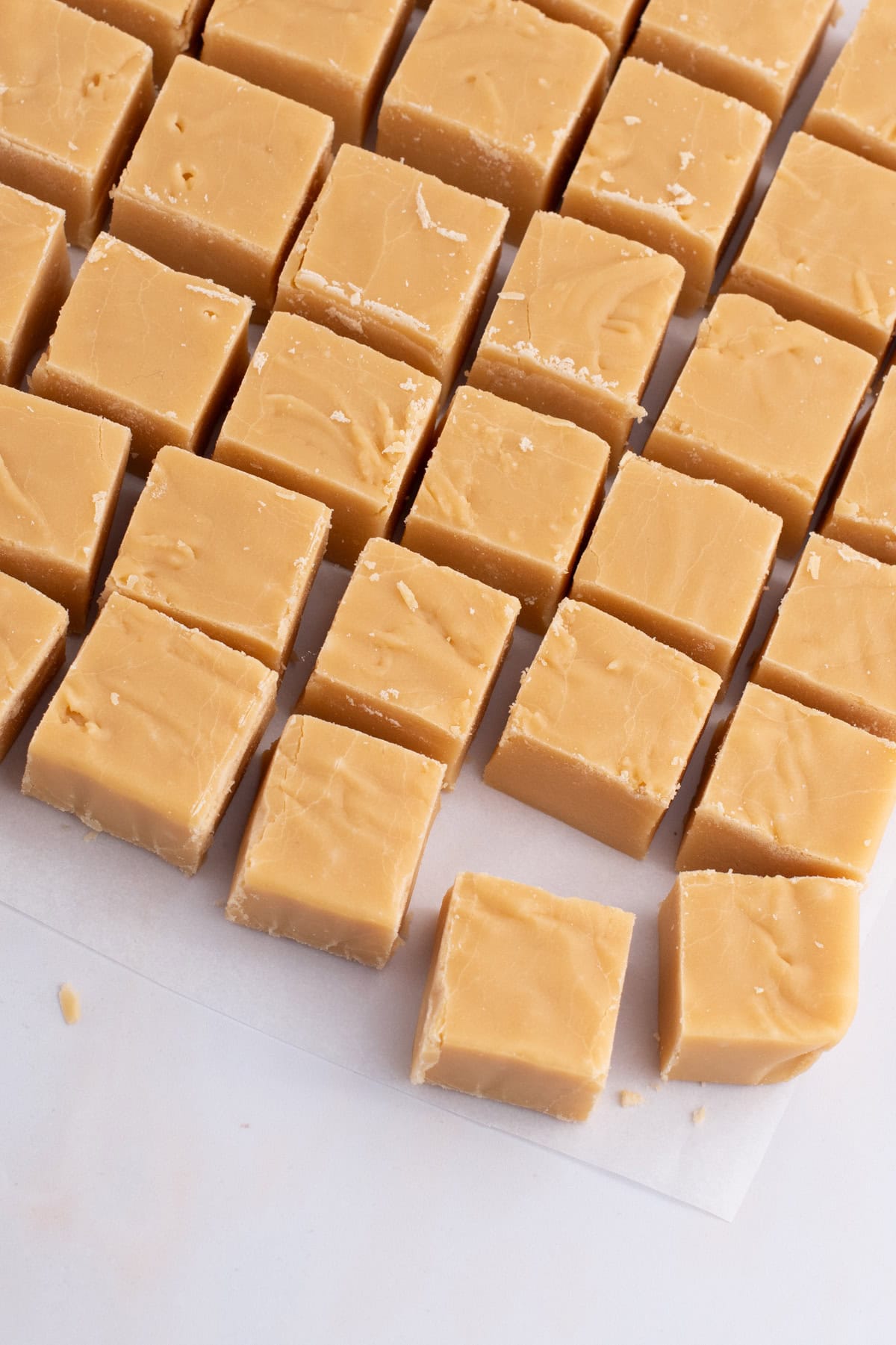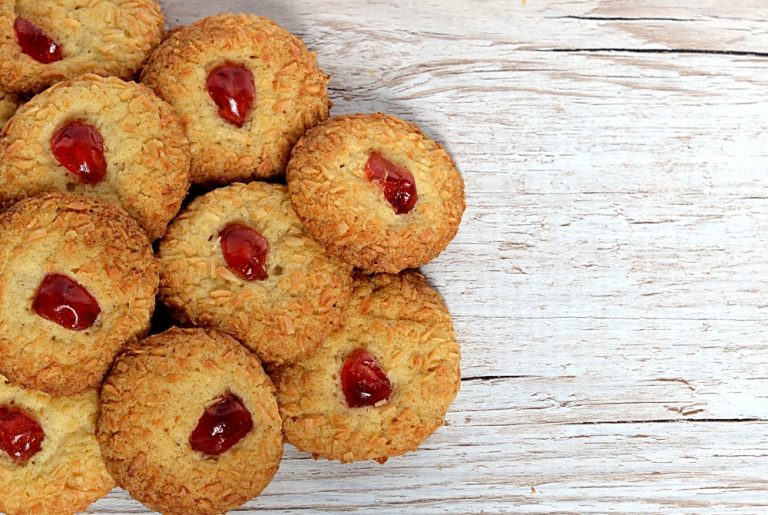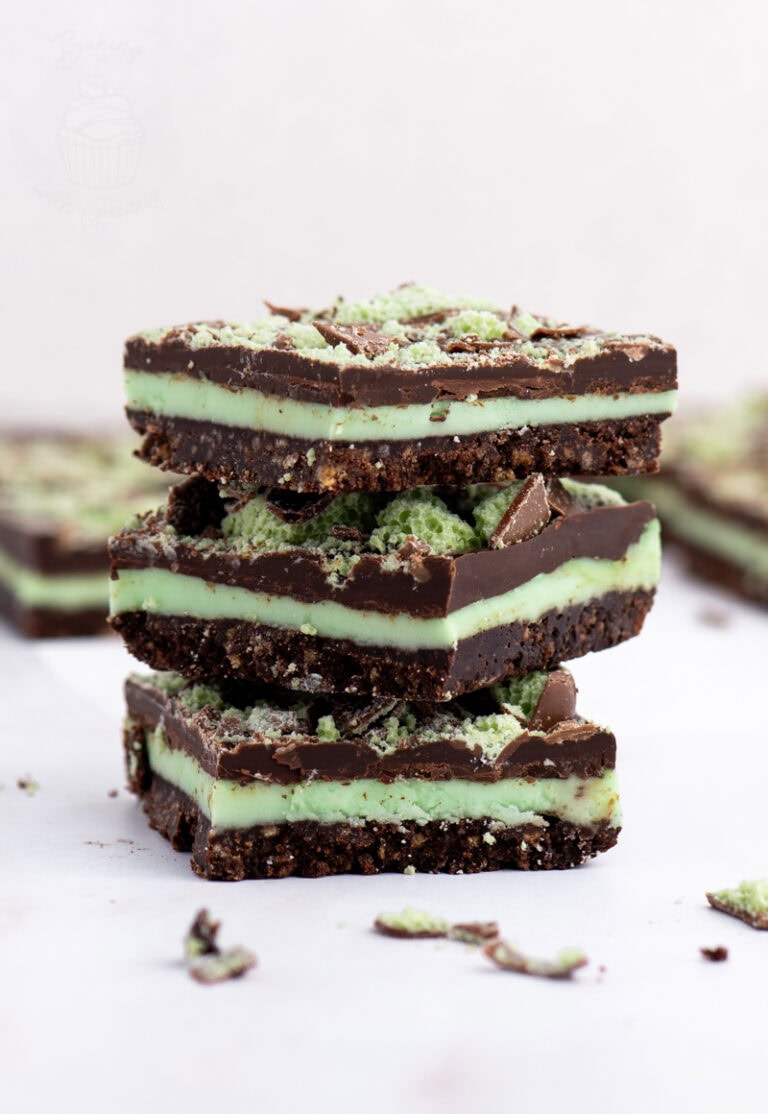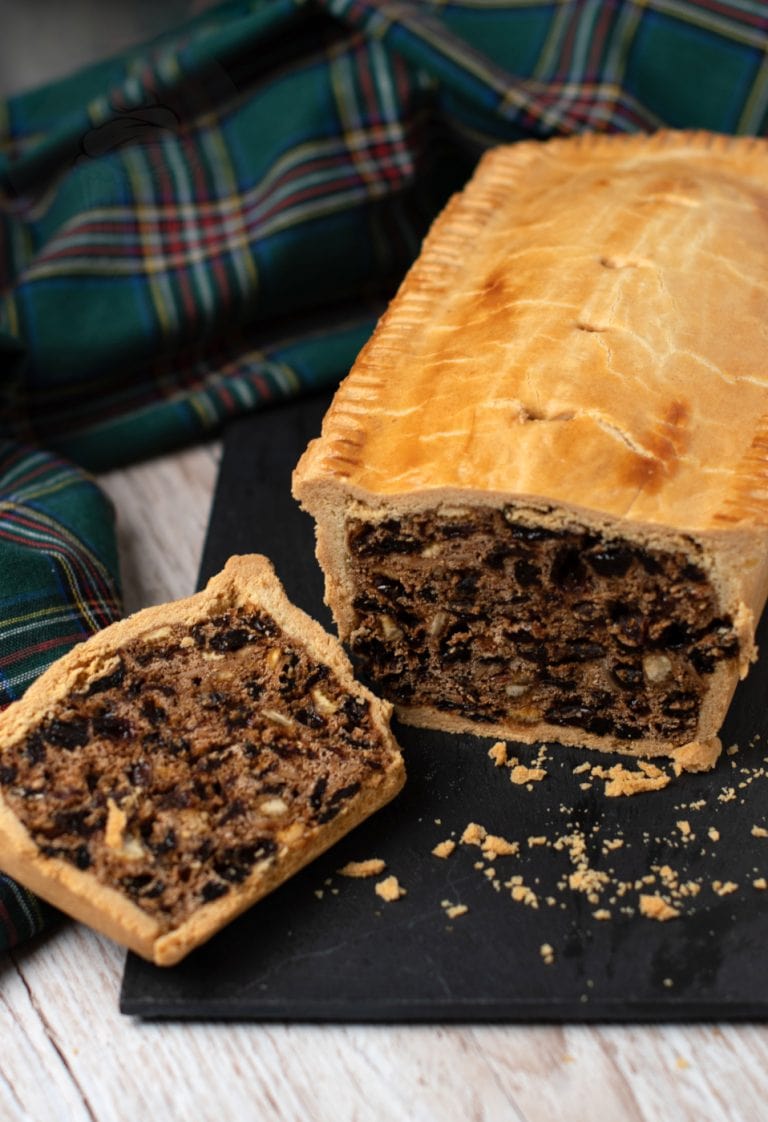Scottish Tablet
Sweet, crumbly, and melt-in-the-mouth, Scottish Tablet is the classic treat you’ll find at weddings, ceilidhs, and just about every celebration in Scotland. Just a few simple ingredients and a bit of patience for a proper homemade batch.
As seen in my debut cookbook, Scottish Bakes.

Confession time… I’m a sugar addict. It will be of no surprise to those around me to be fair! From the moment I wake up to the moment I go to bed, I’m looking for my next sugar hit. It’s certainly not ideal, but growing up in Scotland with sweet treats like Scottish Tablet, it’s really unavoidable.
A couple of weeks ago, I came across a wee image on Facebook that made me laugh. It compared candy floss, syrup and sugar to Scottish tablet, with tablet coming out tops in the sweetness stakes. Probably a pretty accurate comparison to be fair!
Anyone who has indulged in Scottish Tablet will tell you it’s really like nothing else in the world. At first glance, you would be forgiven for assuming it is fudge, but when you bite into a piece, it instantly becomes clear that this is no fudge! With a gritty, melt-in-the-mouth texture and so sweet it makes your teeth ache, it really is quite unique.
Scottish tablet, in theory, is quite easy to make, but it does take a bit of skill to get just right. I would always recommend a sugar thermometer to get the temperature exact and be prepared to use some elbow grease, beating the tablet to its setting point. Even then, the perfect tablet still comes down to a bit of luck. But when it does go perfectly, you’ll end up with the best tablet you’ve ever tasted!

Top Tips for Scottish Tablet:
• Use your biggest pan: Bigger than you think you will need. Trust me! Once the ingredients start to boil, the mix will try to overflow too. And there’s no joy in cleaning hot, sticky tablet disasters from your stovetop.
• A sugar thermometer is a must: This is one recipe where I would always, always recommend using a sugar thermometer. Without it, you are less likely to have success, as it requires a bit of guesswork and experience to know exactly when the tablet has reached the Soft-Ball stage.
• Just beat it: When it comes to beating your tablet, it can take a good bit of elbow grease! Stick with it. You want to beat it until it starts to thicken, but not too thick either. The good news is that you can’t really over-beat tablet – even if it is thicker than you wanted, it’ll still taste great, it just won’t look as pretty and smooth on top.
• Electric whisk is an option: I have heard of some people using an electric whisk to beat their tablet. This isn’t something I have personally tried, but if you struggle with the beating of your tablet or have limited mobility, this could be a good option to consider.
• Score the top: For a perfectly neat tablet, score the top of your tablet to the shape you wish to cut (bars or squares are most traditional) after it’s had a little time to cool, but still warm. This will make it much easier to get a smooth finish when you come to cutting your tablet.

Ingredients for Scottish Tablet:
Caster Sugar
Being sweeter than sweet, sugar was always going to be the biggest ingredient in tablet! Caster sugar is by far the best, due to its finer texture, dissolving easily when combined with the liquids. You can swap to Golden Caster Sugar for a more caramel-y flavour and darker coloured tablet, should you prefer.
Milk
Ideally, you want to use full-fat milk. This is what a traditional homemade Scottish tablet would be made with. However, I have used semi-skimmed in a pinch and had good success.
Butter (or Margarine…)
Salted or unsalted butter is fine; whichever you have to hand.
Or there is the option to use a block margarine. Many tablet purists would disapprove of swapping true butter for margarine; however, I can confirm it works just as well. And with the amount of sugar and the degree of sweetness in the tablet, it means it’s very difficult to tell the difference, in terms of taste. If you do opt for a margarine, just be sure to use a block margarine as opposed to the spreadable kind – the latter will interfere with your tablet setting, due to the lower fat content.
Condensed Milk
Literally one of my most favourite ingredients in baking. Just be sure to leave a little condensed milk in the tin and on the spoon (purely for licking clean!).
Save this recipe!
Want to save this recipe for later? Pop your email below and come back to it when you’re ready to bake.

Scottish Tablet
EQUIPMENT
- 20x20cm Baking Tin (8-inch)
INGREDIENTS
- 900 g Caster Sugar (Superfine Sugar)
- 250 ml Full-fat Milk
- 110 g Butter
- 397 g Condensed Milk (Sweetened Condensed Milk)
INSTRUCTIONS
- Once all the sugar has dissolved add the butter and allow to melt.
- When the butter has melted, add the condensed milk and mix well. Increase the heat and stir continuously while the mixture boils and reaches Soft-Ball stage (120°c/250°F) on your sugar thermometer. This usually takes 15-20 minutes but timing may vary.
- Remove from the heat and allow the mixture to settle a little before beating. Beat with a wooden spoon in the pan until the mixture if almost setting. This may take a good bit of beating!
- Transfer to your pre-greased tray and spread evenly to the edges & corners.
- Leave to set for at least a couple of hours, but ideally overnight. If you want neatly cut squares/bars of tablet, score your tablet in your desired size/shape about 30 minutes into setting. Alternatively, you can simply break the tablet into individual servings once set for a more rustic feel.
Video
IMPORTANT NOTE:
All my recipes are developed using a digital scale and the metric system (grams and millilitres). Cup measurements are available as a conversion but these, unfortunately, won’t always be as accurate. For best results, I always recommend baking with a digital scale.
RECIPE NOTES:
- Storage: Tablet keeps exceptionally well. Once fully set and cut, store it in an airtight container at room temperature – it’ll stay fresh for 2–3 weeks (if it lasts that long!).
- Make Ahead: Homemade tablet is perfect for prepping in advance. You can make it days, or even weeks, ahead of time, making it ideal for parties, gift bags, or bake sales.
- Freezing: Tablet can be frozen, although the texture may become slightly crumblier once defrosted. To freeze, wrap the pieces in baking paper and pop them in a freezer-safe bag or container. Defrost at room temperature before serving.
It is tricky to try to explain what tablet is to someone who has never tried it. Scottish Tablet is truly unique, and although there are some sweet treats that are similar, nothing really quite compares. It is made with milk, butter, condensed milk and A LOT of sugar. It is boiled to a high temperature, before beating the mixture until thickened, and then setting it in a tin until completely cool. It is a truly unique sweet (candy) that is popular with all generations in Scotland.
Scottish Tablet is the best-tasting food in Scotland (sorry, haggis – you’re a close second though). Think of the sweetest fudge you’ve ever had, without the vanilla flavour. And more of a crumbly, melt-in-the-mouth texture. Then multiply the sweetness by about a hundred. You’ll be pretty close to what tablet tastes like!
Traditional Scottish Tablet is actually quite easy to make, but there are a few things that can make or break your success.
You start by dissolving your sugar and milk in a large pan, over a gentle heat. Next, you add your butter and allow that to melt before finally adding your condensed milk. You will increase the heat of your pan to bring everything to a boil, until it reaches Soft-Ball stage (120°c). This is where a sugar thermometer is a must-have!
The final stage of tablet making is the beating. You need to allow the mixture to cool briefly before beating with a wooden spoon. It can take a bit of work, but it will start to thicken. To finish, simply pour your tablet into a greased tin and allow to cool before cutting into bars or squares.
Free-from & Vegan:
Gluten-free: Scottish tablet is naturally gluten-free but be sure to check your ingredients individually when preparing for anyone with intolerances or coeliac disease.
Vegan: To make this a Vegan Scottish Tablet recipe, simply replace the full-fat dairy milk with sweetened soya milk, and use vegan condensed milk. Swap the butter for your dairy-free block margarine.
N.B. Any advice or suggestions to make recipes “free-from” or vegan are purely that – suggestions. Please be careful to double-check all ingredients individually, taking extra caution when serving to those with allergies & intolerances.
For more info on common food allergies, please see food.gov.uk | For more info on coeliac disease, please see coeliac.org.uk | For more info on a vegan diet, please see vegansociety.com
Originally published in May 2017. Updated in July 2025.






Great recipe haven’t had original tablet since my dad passed away true Scott’s man so thank you brings back fond memories so thanks excellent recipe works every time
Why is my tablet not setting properly. It is a bit fudgey. Tastes fantastic though. I used sugar thermometer and follow the recipe to the letter!!
My nana used to make a fudge that came out with a gritty, crumbly kind of texture and I never knew why I couldn’t get it there. This recipe leads me to believe that she was cooking it out of the fudge stage and more into something like this with a grittier texture. I tried with the directions here and added my cocoa and ended up with something very close. Thank you
When I first poured it, it set like chewy toffee which was nice but not what I was after so I put it back in the pot and over low heat melted it before increaqsing to medium heat and bringing to the boil again.
Once it reached 120C again I took it off, rested it an beat it to the point I was working up a sweat and it was turning into almost solid ball in the pot.
Poured to pan and smoothed out and let it sit overnight – this was just in open air of kitchen about 19-20C (I’m in Australia) – wasn’t sure if I should put it in fridge.
This time it was a lot more like what my mum used to make although it’s almost flakey like the consistency of Halva.
Still delicious and melts in the mouth but curious as to whether the flakiness is a side effect of the double heating?
This recipe is amazing, I made this tablet recently and everyone loved it.